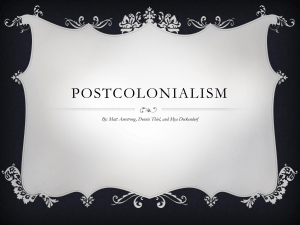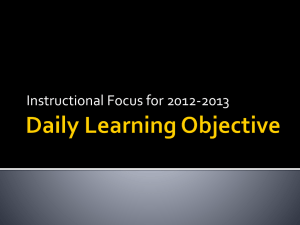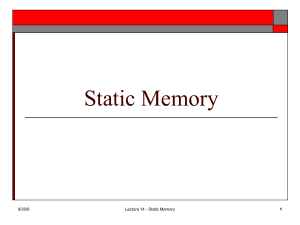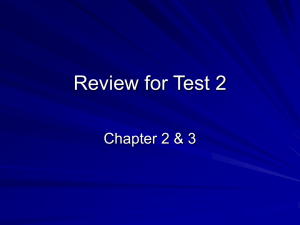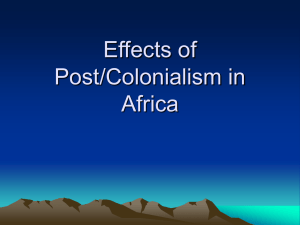Unit Two: Q & A by Vikas Swarup Holly Fritz
advertisement
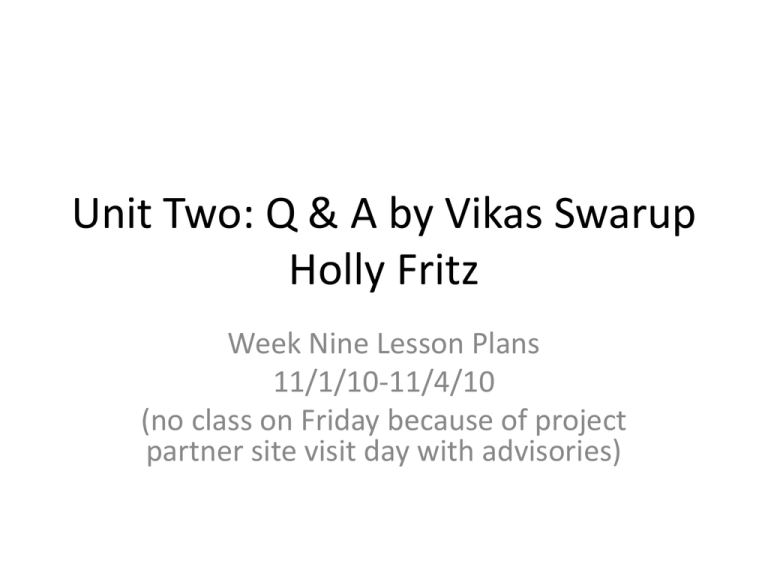
Unit Two: Q & A by Vikas Swarup Holly Fritz Week Nine Lesson Plans 11/1/10-11/4/10 (no class on Friday because of project partner site visit day with advisories) Monday 11/1/10 Learning Goal: SWBAT 1. Summarize the qualities of level one, level two, level three questions and pose these different types of questions about the last two chapters of the book. Do Now: On page 40 • • • • • • Respond to the following quote and questions in complete sentences. Refer to your book. On page 268, Ram says, “… Real life is very different from reel life. Love doesn’t happen in an instant. It creeps up on you and then it turns your life upside down.” What is happening for Ram at this point in the story? What does he mean by “Real life” is different from “reel life”? What does he realize about love? Do you agree/disagree or relate to what Ram says here about love? Explain/. Agenda: 1. Do Now and HW check 2. Preview of the week 3. Leveled question cards 4. Partner work 5. Partner share out HW: organize your interactive notebook! There will be a notebook quiz soon! Tuesday 11/2/10 Learning Goals: SWBAT 1. Demonstrate their comprehension of the plot of the end of the novel by answering a series of level one questions. 2. Prepare for a fishbowl discussion on the end of the novel by responding to level two and level three questions and supporting those answers with evidence from the text. Do Now: On page 42 In the Epilogue Ram says, “I realized a long time ago that dreams have power only over your own mind; but with money you can have power over the minds of others” (p. 316). • What does he mean? • Why does he say this? • Do you agree with him? Why or why not? Agenda: 1. Do Now 2. Level one quiz 3. Fishbowl preparation Homework: 1. Finish fishbowl prep for tomorrow 2. Letter to Ram Q & A by Vikas Swarup Fishbowl Preparation Chart Learning Goal: SWBAT Prepare for a fishbowl discussion on the end of the novel by responding to level two and level three questions and supporting those answers with evidence from the text. Directions: Tomorrow we will be having a fishbowl discussion about the last two chapters and the Epilogue of Q & A. We will use the level two and three questions that you wrote on Monday as the foundation for this discussion. Complete the following chart in preparation for this discussion. Level 2 & 3 Questions 1. How does Ram’s understanding of love change in ‘A Love Story”? (level two question) 2. Why did Ram give Mr. Chatterjee the four lakh ruppees? What does this decision reveal about Ram? (level two) 3. Why does Ram feel so responsible for Nita? (level two) 4. Why does love take time to develop? (level three) Your Answer Quote Learning Goal: SWBAT Q & A by Vikas Swarup Fishbowl Preparation Chart Prepare for a fishbowl discussion on the end of the novel by responding to level two and level three questions and supporting those answers with evidence from the text. Questions 1. Why couldn’t Ram shoot Prem Kumar? (level two) 2. What did Neelima and Nita mean for Ram? Why did he care so much about them? 4. Is revenge ever justified? (level three) Your Answer Quote Homework for Tuesday night: due Wednesday 11/3/10 Directions: For this homework assignment you are required to write a one page letter to Ram. Your letter needs to include a salutation and needs to be addressed to Ram . You will hand this work in and it will count as two homework assignments. Paragraph One: • Introduce yourself. • Tell Ram what you thought of his story. • What do you and Ram have in common? What text-to-self connections were you able to make while reading his story? Paragraph Two: • Tell Ram about an action or decision that he made that you agreed with, or approved of and explain why you feel this way. • Include a quote from the part of the story where he made this decision or action. • Explain why you think he acted this way or made this decision. Paragraph Three: • Tell Ram about an action or decision that he made that you disagreed with and explain why you feel this way. • Include a quote from the part of the story where he made this decision or action. • Explain why you think he acted this way or made this decision. Paragraph Four: • Tell Ram about what you hope his life is like when he is older (in his 30’s)– what are your hopes for him and for the other characters in the story (Nita, Salim, Gudiya, etc.)? Wednesday 11/3/10 (double block) Learning Goals: SWBAT 1. Reflect on the end of the novel by exchanging letters to Ram with a partner and responding in Ram’s voice. 2. Respond to and construct level two and three questions about the end of the novel by participating in a fishbowl discussion. 3. Describe and illustrate the word motif. Do Now: on page 42 Answer the following questions in complete sentences: • What patterns did you notice when you were reading Q & A? • In other words, what kinds of events, or images repeated, or happened over and over again? • Why do you think this might be important? Agenda: 1. 2. 3. 4. 5. 6. Do Now (HW check/collect: fishbowl prep and letter to Ram) Pair Share: letter to Ram Fishbowl guidelines Fishbowl discussion Reflection/debrief on fishbowl Mini-lesson on Motif (go over Do Now and vocab. graphic organizer) Homework: Complete the chart on motif in Q & A. Pair Share: Letter to Ram Learning Goals: SWBAT Reflect on the end of the novel by sharing letters to Ram with a partner and responding in Ram’s voice. Directions: Exchange letters with a partner. Then, on the back of the letter (or a separate sheet of loose-leaf paper if there is no room), respond to the letter as Ram. • • • • Your letter must be at least one paragraph long. Your letter needs to specifically address the letter your partner wrote. Your letter needs to be specific. Your letter needs to be written in Ram’s voice. • When you are finished, return the original letter and your letter to your partner. • Both letters will be turned in to me and graded. • Then, under your Do Now, did writing your letter to Ram, or responding to someone else’s letter as Ram, make your realize anything new about this character, or about the book? Explain. Fishbowl Guidelines Learning Goals: SWBAT Respond to and construct level two and three questions about the end of the novel by participating in a fishbowl discussion. Inner Circle: • Members sit in a circle (with desks) with their fishbowl prep charts and their books in front of them. • Members ask and respond to level two and three questions about the end of the book. • Members speak respectfully and kindly to one another, even when disagreeing (no put downs, or insults– even if you are joking). Outer Circle: • Observes the inner circle according to instructions on the outer circle card. • Does not participate in discussion (silent observers) • Takes notes in INB under the Do Now for today. • Shares observations with inner circle before the circles switch places. Fishbowl Reflection Learning Goals: SWBAT Respond to and construct level two and three questions about the end of the novel by participating in a fishbowl discussion. Directions: Answer the following questions on loose-leaf paper. I will collect this work from you. 1. Are you more comfortable on the inner circle or the outer circle? Why? 2. Did you realize anything new about the book from observing and participating in today’s fishbowl discussion? Explain. 3. How did you contribute to the inner circle discussion? Were your contributions positive? Explain. 4. What can you and others do to make the next fishbowl discussion even better and more productive/focused? Term: Motif My Understanding: 1 2 3 4 Describe: _________________________________ _________________________________________ _________________________________________ _________________________________________ Draw: Further Understanding: How does this word relate to the novel? To the other unit two vocab. words (transgress and/or agency)? What can you add to your description to help you understand the meaning of this word? Learning Goal: SWBAT Describe and illustrate the word motif. Motif Learning Goal: SWBAT Describe and illustrate the word motif. • A motif is a pattern. • A motif is a theme or idea that repeats throughout a work of literature (story, novel). • http://www.youtube.com/watch?v=mc95ndkl DYY Tracking Motifs in Q & A by Vikas Swarup Motifs in the novel 1. 2. Homework for Wednesday 11/3/10, due Thursday 11/4/10 The significance of each identified motif– why is each motif important? What does it mean? What does it reveal about the characters/themes of the book? What is the author trying to communicate through use of this motif? Quote: Find a quote that illustrates/exemplifies each of the two motifs you identified. Thursday 11/4/10 Learning Goals: SWBAT 1. Describe and illustrate colonialism and post-colonialism and make connections between these two concepts/terms and the themes/motifs in Q & A. Do Now: On page 44 • Answer the following question in at least 3 complete sentences! • How is transgression a motif in Q & A? Agenda: 1. 2. 3. 4. Do Now and HW check (chart on motifs in Q & A). Review: Motif and go over/share motifs in the novel, Do Now share-out. Lesson on colonialism and postcolonialism. Unit Two test topics for study. Homework: Complete the Vocabulary Venn Diagram. Review the main events from the whole book in preparation for next Wednesday’s unit test! Term: Colonialism My Understanding: 1 2 3 4 Learning Goal: SWBAT Describe and illustrate colonialism and post-colonialism and make connections between these two concepts/terms and the themes/motifs in Q & A. Describe: Draw: Further Understanding: What is the connection between colonialism and India? Colonialism Learning Goal: SWBAT Describe and illustrate colonialism and post-colonialism and make connections between these two concepts/terms and the themes/motifs in Q & A. • Colonialism refers to a period of history from the late 15th to the 20th century when European countries established colonies on other continents (Asia, South America, Africa). These European nations were motivated by profit from trade and the expansion of their power. In addition, they often believed their European culture and religions (Christianity) were superior to the culture and religions practiced by the people of these other countries/continents and believed they had the right to spread their own culture and religion. Colonialism in India Learning Goal: SWBAT Describe and illustrate colonialism and post-colonialism and make connections between these two concepts/terms and the themes/motifs in Q & A. The British rule over India changed the course of history in India. The British came to India at the start of the seventeenth century. This was the time when the British East India Company was established in India to break the Dutch monopoly over spice trade. The policies of the British East India Company were disliked by Indians and together they revolted against the company. This led to the downfall of the company and rule of India went directly under the Queen. The British claimed India as it’s own and formed laws and policies of their own. Slowly but rapidly, the entire Indian sub continent came under the British rule. By mid nineteenth century, the British introduced the railways, telegraph and postal service in India. This was a move to establish their rule permanently in India. The British passed many acts that were met with dissatisfaction and resentment by the Indians. As a result ,the Indians formed large groups and revolted against the British. Each movement was brutally crushed by the British forces. Leaders like Mahatma Gandhi, Jawaharlal Nehru, Lala Rajpat Rai, Subhash Chandra Bose, etc. arose and openly condemned the British. They were people's leaders who inspired the masses not to be afraid of the forces. Finally after 200 years of British rule, India gained independence from them on 15th August, 1947. Many innocent lives were sacrificed for this achievement and India was also separated from Pakistan. The partition of India and Pakistan spread incidents of brutality and horror in both the countries. But due to the effort of the leaders and the ever sacrificing masses, India was able to gain freedom from the British and progress till the present times. http://www.youtube.com/watch?v=kxYQ4CXoIwg Term: Post-Colonialism My Understanding: 1 2 3 4 Learning Goal: SWBAT Describe and illustrate colonialism and post-colonialism and make connections between these two concepts/terms and the themes/motifs in Q & A. Describe: Draw: Further Understanding: What is the connection between colonialism and post-colonialism in India? Post-colonialism Learning Goal: SWBAT Describe and illustrate colonialism and post-colonialism and make connections between these two concepts/terms and the themes/motifs in Q & A. • Postcolonialism refers to reactions to, and analysis of, the lasting effects of colonialism on the people who were formerly colonized. • The goal of post-colonialism is combating and exposing the negative effects of colonialism on cultures. • Post-colonialist thinkers recognize that many of the assumptions which underlay the "logic" of colonialism are still active forces today. Exposing the racist nature of these assumptions will remove their power. • A key goal of post-colonial theorists/writers is clearing space for multiple voices. This is especially true of those voices that have been previously silenced (called subalterns) by oppressive colonial/European forces. • http://www.youtube.com/watch?v=stzpu-cS4_4 Homework for Thursday 11/4 Due Monday 11/8/10 Directions: Complete the Venn Diagram by referring to your class notes/vocabulary graphic organizers on colonialism, postcolonialism, the subaltern voice. You should replicate this Venn Diagram on page ____ of your Interactive notebook. In each circle, describe what each term means. In the space that overlaps, describe the relationship between each of these three terms. Then, next to each of the three lines on the outside, write words, names, phrases the remind you of these three concepts (either from history class, or from the novel, or from your knowledge of the world). Colonialism: What does it mean? How does it relate to India? Subaltern: What is it? How does it relate to India? PostColonialism: What is it? How does it relate to India?

